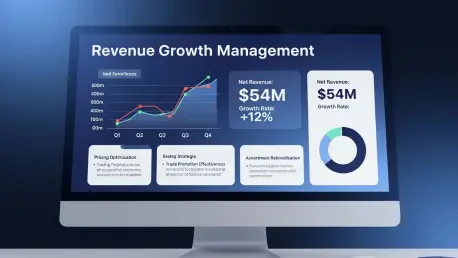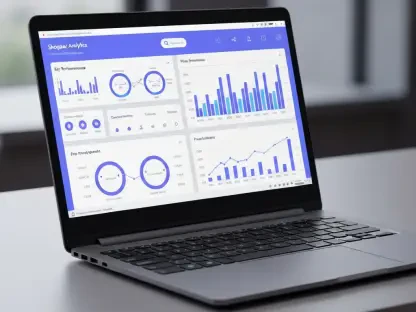In the fast-evolving consumer goods industry, staying ahead of market dynamics requires more than just traditional strategies; it demands a forward-thinking approach to technology and data management. Georgia-Pacific, a prominent manufacturer of well-known paper goods brands such as Quilted Northern, Brawny, Dixie, and Vanity Fair, has taken a significant step forward by investing in revenue growth management (RGM) optimization tools. This strategic move aims to bolster sustainable growth amid fierce competition. By integrating intelligent automation and predictive analytics, the company is transforming its end-to-end processes, enhancing decision-making capabilities, and ensuring agility in response to unexpected challenges. The adoption of these advanced tools marks a departure from outdated manual methods, positioning Georgia-Pacific as a leader in operational efficiency. This shift not only addresses past limitations in managing rapid market changes but also sets a benchmark for others in the sector seeking to thrive in a technology-driven landscape.
Embracing Technology for Operational Agility
The transition from manual processes to automated systems has proven to be a game-changer for Georgia-Pacific in navigating the complexities of the consumer goods market. Historically constrained by limited bandwidth to adapt swiftly to fluctuations, the company recognized the urgent need for robust technological solutions. By incorporating generative capabilities, streamlined analytics, and intelligent decision management tools, operations have seen a marked improvement. Sensor data, business rules, and recommender systems now play a critical role in manufacturing, replacing cumbersome Excel spreadsheets with real-time, automated insights. This overhaul has drastically enhanced data speed and communication, providing sales teams with unprecedented visibility into supply and demand dynamics through seamless back-end integrations. The result is a more responsive framework that can anticipate and react to market shifts with precision, ensuring that strategic decisions are both timely and informed by accurate, actionable information.
Furthermore, the adoption of predictive analytics has empowered Georgia-Pacific to model untested scenarios and uncover hidden potential in its operations. These tools enable a deeper understanding of market trends, allowing the company to stay one step ahead of competitors. Unlike manual processes that often lagged behind real-time needs, automated systems deliver insights at a pace that matches the industry’s rapid evolution. This capability is particularly vital in managing promotions and demand planning, where split-second decisions can determine success. Insights from industry discussions reveal that such technological integration is not merely an upgrade but a necessity for sustaining growth. The enhanced visibility across operations ensures that every department, from production to sales, operates with a unified view of data, minimizing errors and fostering a collaborative environment where strategic goals align with day-to-day execution. This comprehensive approach underscores the transformative power of technology in overcoming traditional operational hurdles.
Strategic Investment in RGM Tools
Deciding where to allocate resources for operational optimization is a complex challenge that Georgia-Pacific has tackled with careful deliberation. According to Chad Watson, the Market Operations General Manager, impulsive investments driven by cost considerations alone can lead to suboptimal outcomes. Instead, a strategic approach is essential, focusing on tool maturity, organizational capabilities, and specific use cases such as post-event data analysis or demand forecasting. Factors like stakeholder acceptance, implementation hurdles, and compliance requirements must also be weighed. Industry experts echo this sentiment, emphasizing the importance of learning from past successes—both within the company and across the sector—to ensure alignment with customer expectations and long-term objectives. This methodical evaluation helps in selecting tools that not only address immediate needs but also support scalable growth, avoiding the pitfalls of short-sighted technological adoption.
Beyond the selection of tools, the broader industry trend points to a collective push for end-to-end visibility in promotion and demand planning. Predictive analytics stands out as a cornerstone for anticipating market shifts and optimizing results, a perspective supported by seasoned professionals in the consumer goods space. Georgia-Pacific’s investment decisions reflect this trend, prioritizing systems that integrate data across functions for a holistic view of operations. However, the challenge lies in balancing the allure of cutting-edge technology with practical applicability. Rushing into unproven solutions can disrupt workflows, while a measured approach ensures that investments yield tangible benefits. By focusing on data-driven strategies that resonate with organizational goals, the company has managed to enhance its responsiveness to market changes. This careful calibration of technology adoption highlights the nuanced decision-making required to turn RGM tools into a competitive advantage, setting a precedent for others in the industry to follow.
Balancing Automation with Human Oversight
While automation has revolutionized Georgia-Pacific’s approach to RGM, there remains a critical need for human oversight to ensure the accuracy and relevance of predictive tools. Automated systems, though powerful, are not infallible and can sometimes produce misleading forecasts if left unchecked. Chad Watson has underscored the importance of maintaining a human-centric process, where clear communication and governed data interpretation are prioritized across functional teams. This balance prevents over-reliance on technology, ensuring that data-driven insights are contextualized through collaborative discussions. By keeping decision-makers at the heart of the process, the company can refine strategies based on real-world nuances that algorithms might overlook. This approach fosters a synergy between machine precision and human judgment, creating a robust framework for tackling the unpredictable nature of the consumer goods market.
Additionally, the emphasis on human involvement extends to how data is shared and acted upon within the organization. Technology serves as a facilitator, but the ultimate responsibility lies with teams to translate insights into effective actions. This requires a culture of accountability and continuous learning, where feedback loops refine both the tools and the decision-making processes. Industry observations suggest that companies excelling in RGM optimization are those that prioritize such collaborative environments, ensuring that automation enhances rather than replaces human expertise. Georgia-Pacific’s commitment to governed processes has allowed it to mitigate the risks associated with unchecked automation, maintaining a competitive edge through informed, strategic choices. This delicate interplay between technology and people illustrates a broader lesson for the sector: sustainable success hinges on integrating advanced tools with the irreplaceable value of human insight, especially in navigating complex market dynamics.
Reflecting on a Path to Sustainable Success
Looking back, Georgia-Pacific’s journey with RGM optimization tools demonstrates a pioneering effort to blend technology with strategic vision in the consumer goods arena. The shift from manual to automated systems marked a pivotal moment, enabling the company to respond adeptly to market demands with improved visibility and efficiency. Thoughtful investments, guided by insights from experts like Chad Watson, ensured that each technological step aligned with overarching business goals. The balance struck between predictive analytics and human oversight proved instrumental in avoiding the pitfalls of over-automation. As the industry continues to evolve, the lessons learned from this experience offer a roadmap for others—prioritizing adaptability, governed processes, and a commitment to data-informed collaboration. Moving forward, the focus should remain on refining these integrations, exploring emerging technologies, and fostering cross-functional dialogue to sustain growth in an ever-changing landscape.









